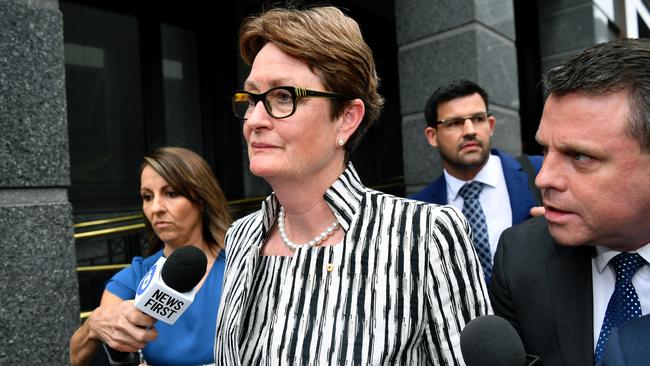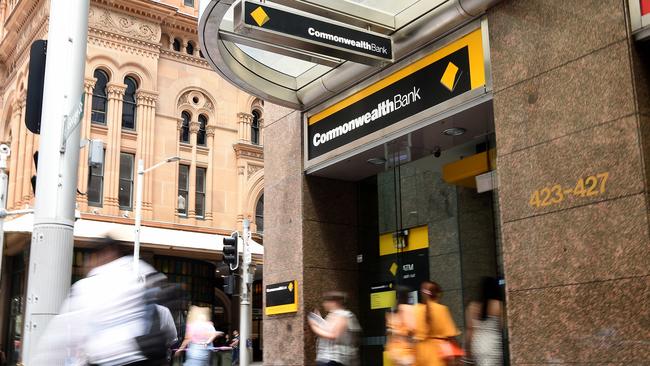
Just eight months into taking charge as chairman of Commonwealth Bank of Australia, the first crisis hit which would later come to define Catherine Livingstone’s five years at the very top of the nation’s biggest bank.
Until then CBA had been able to isolate and power through a string of scandals that had consumed its wealth management business. It had put shareholders offside, it was battling regulators, and customers saw it as complicated and aloof. But a massive money laundering legal action by financial crimes regulator Austrac that exploded in August 2017 shook CBA like nothing before.
Livingstone flagged her retirement on Wednesday saying with management stability and strategic improvements, now was the right time for the $180bn bank to go through a change of chairman.
The former chartered accountant had become one of the first female chief executives of a major ASX-listed company – Cochlear – and then went on to become chair of Telstra. It was there she forged a reputation for inner-toughness while a strikingly similar situation unfolded to what she would soon face at CBA: the need to rebuild bridges with government, regulators and consumers. In Telstra’s case following the divisive tenure of former chief executive Sol Trujillo.

Livingstone says CBA is certainly in a better position today from when she started as chair but this was not a time for the board to let its guard down.
“I don’t think you’d ever use the word satisfied,” she tells The Australian.“ I think the bank is in a very, very good place to keep on with the operational improvement and the strategic intensity. There’s always a huge amount to do. But the bank has the capability to do it,” she says.
Stepping into the chairman role is CBA director and former long-serving BlueScope steel chief executive Paul O’Malley who takes charge in August when the bank signs off on its full year accounts.
After initial efforts by CBA management to diminish the Austrac move, the gravity of the landmark claim that included allegations of repeated warnings about the bank’s anti-money laundering shortcomings became apparent.
In the days following the Austrac allegations surfacing, Livingstone set the tone from the very top by forcing the bank to acknowledge the deeper problems that the legal action represented.
She quickly stripped the entire executive team of millions of dollars of bonus payments and slashed directors fees. Despite booming profits and a healthy share price, the move sent a message about the collective failure of management and the board when it came to protecting CBA’s reputation.

She also placed her executives under intense supervision over how they dealt with the Austrac allegations. Significantly the bank became more cooperative with regulators and began overhauling money laundering protections.
Two weeks after the Austrac allegations broke the then chief executive Ian Narev was told these were to be his final months with the bank and a search was underway for a replacement.
In the period that followed four directors left the board, nearly the entire executive team left and a new CEO was needed to be installed. As well as an explosive Austrac legal action, CBA was facing a separate governance investigation from bank regulator APRA, there was a shareholder class action, and the Turnbull government had agreed to hold a Royal Commission into banking misconduct. Adding to this was the additional pressure CBA faced in its outsized role of funding the nation’s businesses, looking after investors and keeping the savings of millions of Australians safe.
Livingstone, acknowledged the Austrac period was one that represented a “huge challenge” for the bank, but the lesson for chairman even today remains to keep calm in the face of the storm and remain analytical about the problems.
“You come into a role and you can’t look at everything that has to be done...obviously you work through the issues but you can’t be overwhelmed by everything you look at. You just have to take it one bite at a time”.
“The key is to look at the team you are building, rather than all the problems you have to face because the team will address the problems if it’s strong enough”.
In June 2018 the bank settled with Austrac for what was then a record $700m fine – a figure that has since been eclipsed by Westpac’s $1.3bn Austrac fine.
‘First strike’
The groundwork for Livingstone’s tenure had started when CBA was hit with a shareholder strike in 2016 – the first for an Australian bank – while there was discontent over bonus payments it pointed to stresses already underway.
“The first thing that needed to be tackled was the first strike that had happened in 2016. So that gives you a focus and way of getting into the organisation and getting to know people”.
Livingstone faced intense criticism through the January 2018 appointment of retail banking boss Matt Comyn to the role of chief executive officer. Not only was he relatively young (42) for a major bank undergoing a crisis, Comyn was part of the same executive team responsible for the Austrac breaches.
Along with Livingstone Comyn has steadily rebuilt the bank, restored its battered reputation and improved shareholder returns. It emerged in the Hayne royal commission of Comyn’s efforts to challenge Narev when it came to standing up for customers.
Comyn also became the banking industry’s public face during Covid when repayments on tens of billions of dollars of loans were paused as the economy ground to a halt and workers stood down.

Livingstone says Comyn’s appointment was a “very, very big” moment for the board. “And as it has transpired it was a very important and very successful decision because Matt then led the rejuvenation of the management team as I was rebuilding the board”.
She said from this point it has been a strong relationship between the board and management which has withstood the challenges that followed including the massive economic shock of Covid – the second big crisis of her tenure.
But it was the confronting APRA review that charted CBA’s corporate fall from grace following the Austrac legal action that Livingstone said in hindsight “was the best thing that happened” to CBA as it set it up in the way it tackled future shocks.
“It was very detailed, and gave us a road map which was the focusing point. It provided the platform and was an enabler for much broader development and evolution in the bank, not just addressing its initial inquiry, but thinking more broadly and more strategically about how the bank had to reposition itself, both internally and the way it worked”.
O’Malley, who joined the board in early 2019 and also sits on the board of retailer Coles, says CBA “is one of the most important institutions in Australia”.
He says the leadership shown by Livingstone and Comyn through the Covid pandemic highlights the important role CBA can play in supporting the economy.
“It’s essential that we continue to undertake that role,” O’Malley told The Australian.
O’Malley forged his reputation during his time at BlueScope in reinventing its processes to become one of the nation’s biggest manufacturers. In doing this he secured a rare consensus between unions and management to save the steelmaker’s Australian flagship operations.
As incoming CBA chairman O’Malley’s first priority remains Livingstone’s attention to building a capable board and management. And then the bank needs to be prepared for broader changes to its operating environment.
“We have to ensure that we focus on fast-evolving digital changes in the economy; a focus on sustainability; having the most relevant products and services and making sure we keep the foundations improving,” he says.
From setting interest rates, paying a banking levy, to writing off loans, CBA often faces conflict between customers, shareholders and often the government. O’Malley acknowledges there will be conflict among stakeholders of what CBA should be as a bank.
“Our role is to make sure that we articulate what we’re doing and why and then to engage with those who want to challenge that, which is an entirely appropriate process,” he says.
johnstone@theaustralian.com.au



